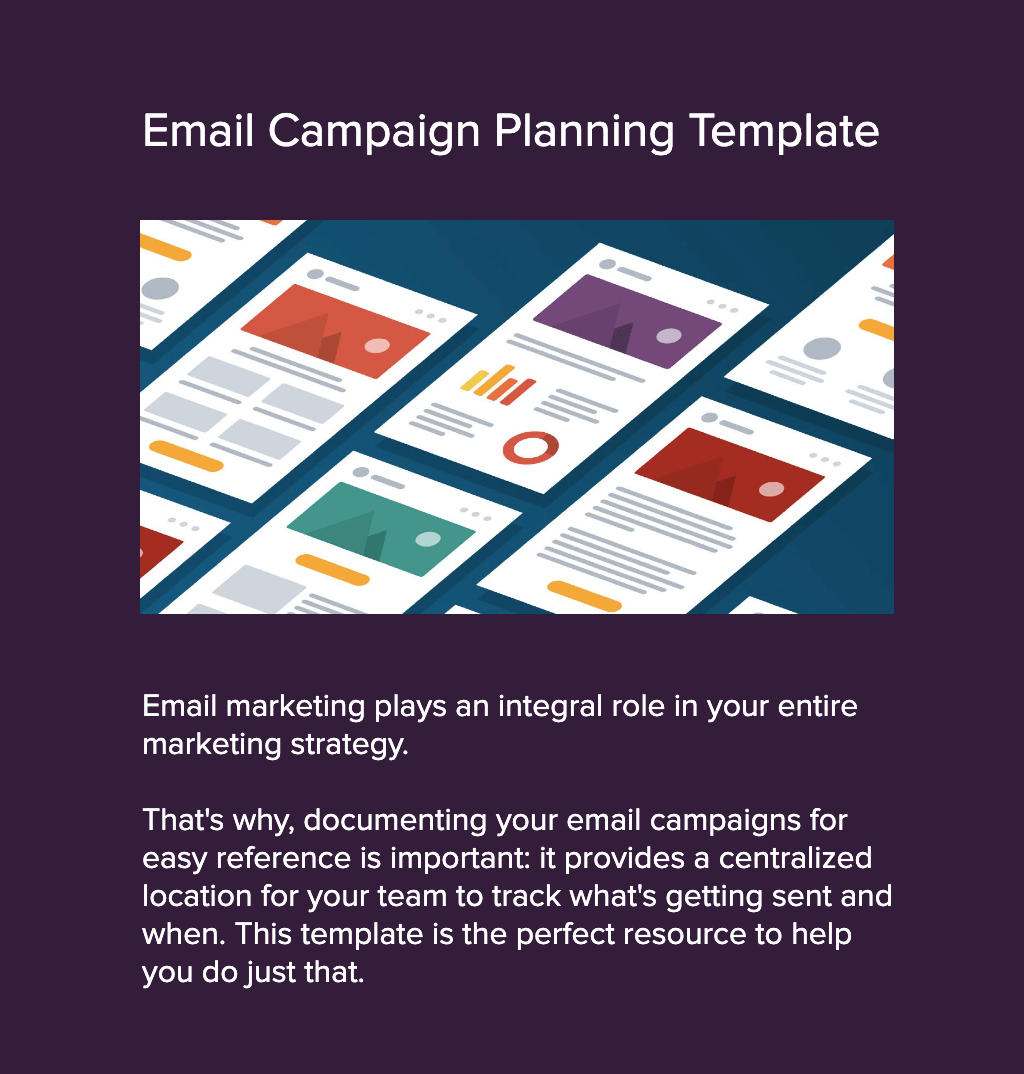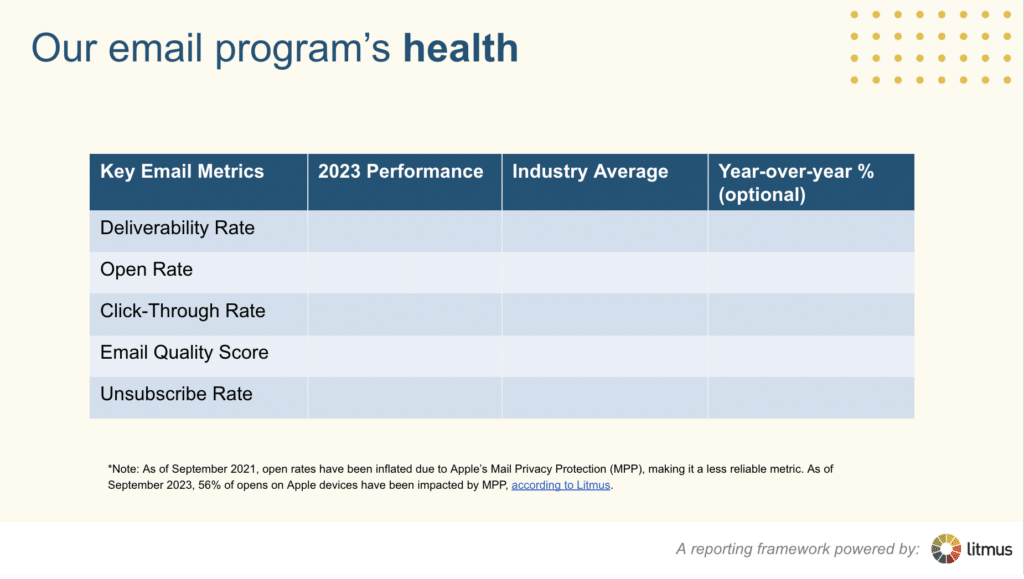How to Craft an Effective Email Marketing Strategy
Email marketers don’t wear many hats—they wear them all. 🎩 We asked email marketers what they’re responsible for in this year’s State of Email Workflows report, and out of a list of eleven options from design to development to deliverability, 22% said they handle ‘all of the above.’
When nearly a quarter of all email marketers routinely manage eleven essential functions in their team, having an email marketing strategy is non-negotiable to focus those important efforts and move the marketing needle!
Here’s what you need to know about email marketing strategies and how to create a plan that drives email ROI for even the busiest teams.
What is an email marketing strategy?
An email marketing strategy is a plan that outlines who you send to, what your goals are, and how you’ll achieve them. Email marketing teams use strategies to prioritize their work when there’s too much on their plates and help everyone work toward common goals.
Why every team needs an email marketing strategy
When your latest campaign was due yesterday and you have a mile-long backlog of campaign ideas, taking a moment for long-term planning feels like, well—a low priority. Email marketing strategies might also feel excessive if you’re a party-of-one email team. However, every team benefits from an email marketing strategy. Here’s why.
- Spend your budget wisely. Email marketing is an investment, and tools like your email service provider (ESP) don’t always come cheap. Defining a strategy helps you prioritize where to spend your budget and what your team needs.
- Focus on a few projects at a time. You can’t do everything all the time, and an email strategy helps you decide which projects make the most sense for your audience and goals right now.
- Sync up with your team. It’s not enough to assume your team and other departments are all on the same page—put everything in writing so collaboration is crystal clear.
- Minimize disruptions. Sometimes, your teammates are out of work, your team grows, or responsibilities shift. Getting ideas and workflows out of your head and into a shared document smoothes out disruptions if you need to pick up where someone left off.
- Review expectations vs. reality. Your vision is clear at the beginning of a project, but it’s easy to forget your plans once you get to work. Establishing an email marketing strategy lets you review your intentions to keep on task.
Include these 8 documents in your email marketing strategy
Your email marketing strategy should be the guiding force behind all of your email marketing decisions, and chances are, you make a lot of decisions. So, a full email marketing strategy covers plenty of territory.
Email marketing is always changing, though, so don’t worry if your strategy never feels ‘finished’—it can grow with your team. Here’s what you can add to your email marketing strategy to be as prepared as possible.
- Overall marketing plan, including your target audience, goals, and list-building strategy.
- Campaign calendar to track when you create and send each email.
- A guide to your customer segments and how you organize them in your ESP
- Style guides to maintain a visual brand
- A list of the email marketing metrics you measure
- Testing and optimization plan to send great emails every time
- Automation and customer funnel map
- Regulations and compliance
Now let’s explore each category a little more (and check out a few email marketing strategy templates)!
1. Email marketing program details
If you’re new to email marketing or organizing work in a new role—start here. An overall email marketing plan is a single-page document that covers the basics of your work. Here’s what to include:
- Email marketing goals. What do you want your emails to do? List a few primary goals, like driving website sales, increasing product awareness, or improving deliverability on a neglected email list. Adding a timeframe to these goals, like your annual or quarterly priorities, is helpful.
- Audience overview. Who do you send to? Collaborate with other marketing and sales departments to get a high-level understanding of your target audience.
- Email types. What types of emails do you send? You might send transactional and promotional emails, a recurring newsletter, sales campaigns, welcome sequences, onboarding flows, and more.
- List-building strategy. How will you build a quality email list? Document your lead magnets, signup forms, single- or double opt-in stance, and list cleaning routine.
2. Campaign calendar
Our annual State of Email Workflows Report found that 62% of email teams spend two weeks or more to build an email, so if you need to create a new email campaign, you better start early. Create a spreadsheet to track current and upcoming email marketing campaigns you need to plan, build, test, and send so your team can stay on schedule. Feel free to copy our free email campaign planning template!

3. Customer segmentation and personalization plan
‘Customer segments’ are specific groups of your email list, and splitting up and tagging these groups helps you organize which email campaigns to send to whom. For example, you only want to send an upsell message to current customers and welcome emails to new newsletter subscribers.
Create a list of all the customer segments you send to and what criteria you use to identify those subscribers to stay organized. Bonus: you’ll thank yourself later for organizing customer segments if you ever need to migrate ESPs. 😉
Your email marketing strategy should also detail how and when you’ll personalize emails. Get your copy of our ultimate email personalization guide to find new ways to stand out in a crowded inbox.

4. Style guide
An email style guide sets standards for the visual appearance of your emails so that every message you send is consistent with your branding. Your email style guide should include details like:
- Text considerations like envelope copy and tone
- Image guidelines like size and style
- Call-to-action references like code snippets for your go-to bulletproof buttons
- Frequently used content including email headers, disclaimers, and icons
- Personalized and dynamic content rules
- Templates and modules
Need style inspiration for your brand? Check out The 2023 State of Email Design Report to learn how best email marketers are creating email.
5. Email marketing metrics
You’ll have different goals depending on the type of email you send. For example, use click-through rate to measure engagement with your email newsletter and email marketing ROI to prove the power of your promotional messages.
Your email marketing strategy needs to list out the email marketing KPIs you’ll track so you know what to measure. Common email marketing metrics include:
- Open rate
- Unsubscribe rate
- Deliverability
- Click-through rate
- Bounce rate
- Conversion rate
- Email quality score
Once you choose your email marketing KPIs, make a copy of our email reporting template to organize and share your wins.

6. Testing and optimization plan
Teams invest a lot of time into email marketing, as you can tell by *gestures widely* all of this. All of that effort, plus the trust that customers place in your brand when they sign up for emails, means every message needs to look perfect and make it to the inbox.
Include a plan to test your emails, optimize deliverability, and improve future campaigns based on email insights.
7. Email automation strategy
Email automation sends the right message at the right time to subscribers, and email marketers lean on these automations in their strategy.
Our research revealed that just over half of all email teams automate their onboarding or post-purchase emails—and that’s just one sequence. Subscriber re-engagement campaigns, customer winback, and customer birthdays are among the other automated emails marketers love.
Create a space in your email marketing strategy to map out your email marketing funnel and the automations you’ll use along the way.
8. Regulations and compliance guide
Email marketing leaves a lot of room for creativity and experimentation, but there are still rules. Be sure you and your team are aware of international email laws that apply to you, data privacy best practices, and changes to the email marketing landscape like Apple’s Mail Privacy Protection (MPP).
Email marketing best practices to build into your strategy
Everyone’s email marketing strategy is a bit different. Even your own strategy can change over time! But there are some best practices you need to carry through all of your planning iterations:
- Create time and space to A/B test your emails, from subject lines to email length and automation timing
- Share what you learn about subscribers with other teams. Cross-channel integration between email, social media, sales, and product teams creates a cohesive experience for potential customers at every touchpoint.
- Prioritize accessibility into your email development and design so everyone can enjoy your messages
- Optimize across devices so your email looks perfect no matter how subscribers view it
- Leverage integrations between your email service provider, email builder, testing platform, and project management tool to stay organized
Start crafting more effective email marketing strategies today
You can invest hours and hours into a meticulous email marketing strategy, but you won’t know how it works until you get it into inboxes! Efficient building, previews, and testing with Litmus make it easier to bring your email ideas to life, and analytics show you what subscribers think.

Kayla Voigt
Kayla Voigt is a freelance writer
